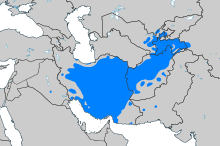Persie leid
| Persie | |
|---|---|
| fārsi | |
| فارسی | |
 Fārsiwritten in Persie (Nastaʿlīq script) | |
| Pronunciation | [fɒːɾˈsiː] |
| Native tae |
|
Native speakers | 45 million (2007)[6]– 60 million (2009)[5] (110 million tot speakers)[5] |
Indo-European
| |
Early forms | |
Staundart forms | |
| Dialects | |
| Offeecial status | |
Offeecial leid in |
|
| Regulatit bi | |
| Leid codes | |
| ISO 639-1 | fa |
| ISO 639-2 | per(B)fas(T) |
| ISO 639-3 | fas–inclusive codeIndividual codes: pes–Wastern Persieprs–Dari leid(Afghan Persie)tgk–Tajikiaiq–Aimaq dialectbhh–Bukhori dialecthaz–Hazaragi dialectjpr–Judeo-Persiephv–Pahlavanideh–Dehwarijdt–Judeo-Tatttt–Caucasian Tat |
| Glottolog | fars1254[7] |
| Linguasphere | |
 Auries wi monie Persie speakers (wi dialects an aw) | |
 Kintras whaur Persie is an offeecial leid | |
Persie(local name:فارسی,FārsiIPA:[fɒːɾˈsi]) is anIranie leidathin theIndo-Iraniebrainch o theIndo-European leids.It is widely spoken inIran,Afghanistan,Tajikistan,Uzbekistanan tae some extent inArmenie,Iraq,Bahrain,anOman.
The Persie leid, whase native names is فارسیFārsi,Dari(the dialect o Afghanistan) orFārsi-ye-Dari(Dari Persian), can be clessifee'd linguistically as a conteenuation oMiddle Persie,the offeecial releegious an leeterar leid oSassanid Persie,itsel a conteenuation oAuld Persian,the leid o thePersiae EmpireinAchaemenidsera.[8]Persie is apluricentric leidan its grammar is seemilar tae that o mony contemporar European leids.[9]The Persie leid haes been a medium for leeterar an scienteefic contreibutions tae the eastren hauf o theMuslim warld.
Persie haes haed a conseederable influence on neebourin leids, in parteecular theTurkic leidsinCentral Asie,Caucasus,anAnatolie,neebourin Iranie leids, as weel asArmenie,Arabican ither leids. It haes exertit a strang influence on Sooth Asie leids an aw, speciallyUrdu,as weel asHindi,Punjabi,SindhianBengali.[8][9][10][11][12][13]
References
[eedit|eedit soorce]- ↑abcSamadi, Habibeh; Nick Perkins (2012). Martin Ball; David Crystal; Paul Fletcher (eds.).Assessing Grammar: The Languages of Lars(in Inglis). Multilingual Matters. p. 169.ISBN978-1-84769-637-3.
- ↑"IRAQ"(in Inglis).Retrieved7 November2014.
- ↑Pilkington, Hilary; Yemelianova, Galina (2004).Islam in Post-Soviet Russia(in Inglis). Taylor & Francis. p. 27.ISBN978-0-203-21769-6.CS1 maint: ref=harv (link):"Among other indigenous peoples of Iranian origin were the Tats, the Talishes and the Kurds"
- ↑Mastyugina, Tatiana; Perepelkin, Lev (1996).An Ethnic History of Russia: Pre-revolutionary Times to the Present(in Inglis). Greenwood Publishing Group.ISBN978-0-313-29315-3.CS1 maint: ref=harv (link),p. 80: "The Iranian Peoples (Ossetians, Tajiks, Tats, Mountain Judaists)"
- ↑abcdefWindfuhr, Gernot:The Iranian Languages,Routledge 2009, p. 418.
- ↑Mikael Parkvall, "Världens 100 största språk 2007" (The World's 100 Largest Languages in 2007), inNationalencyklopedin
- ↑Nordhoff, Sebastian; Hammarström, Harald; Forkel, Robert; Haspelmath, Martin, eds. (2013)."Farsic – Caucasian Tat".Glottolog.Leipzig: Max Planck Institute for Evolutionary Anthropology.
- ↑abProfessor. Gilbert Lazard,:The language known as New Persian, which usually is called at this period (early Islamic times) by the name of Dari or Parsi-Dari, can be classified linguistically as a continuation of Middle Persian, the official religious and literary language of Sassanian Iran, itself a continuation of Old Persian, the language of the Achaemenids. Unlike the other languages and dialects, ancient and modern, of the Iranian group such asAvestan,Parthian,Soghdian,Kurdish,Balochi,Pashto,etc., OldMiddleand New Persian represent one and the same language at three states of its history. It haed its origin inFars(the true Persian kintra frae the historical point o view) an is differentiatit bi dialectical features, still easy recognisable frae the dialect prevailin in north-wastren an eastren Iranin (Lazard, Gilbert 1975, “The Rise of the New Persian Language” in Frye, R. N., The Cambridge History of Iran, Vol. 4, pp. 595–632, Cambridge: Cambridge University Press.
- ↑abRichard Davis, “Persian” in Josef W. Meri, Jere L. Bacharach, “Medieval Islamic Civilization”, Taylor & Francis, 2006. Ppg 602-603. “The grammar of New Persian is similar to many contemporary European languages.” “Persian has, in general, confined its borrowings from Arabic to lexical items, and its morphology is relatively unaffected by the influence of Arabic, being confined to a few conventions such as (usually optional) use of Arabic plurals for Arabic-derived words (as an English speaker may use Latin plurals for Latin loan words in English)... Similarly, the core vocabulary of Persian continued to be derived from Pahlavi, but Arabic lexical items predominated for more abstract or abstruse subjects and often replaced their Persian equivalents in polite discourse.”
- ↑Lazard, Gilbert, "Pahlavi, Pârsi, dari: Les langues d'Iran d'apès Ibn al-Muqaffa" in R.N. Frye, "Iran and Islam. In Memory of the late Vladimir Minorsky", Edinburgh University Press, 1971.
- ↑Nushin Namazi (24 November 2008)."Persian Loan Words in Arabic".Archived fraethe originalon 20 Mey 2011.Retrieved1 Juin2009.
- ↑Classe, Olive (2000).Encyclopedia of literary translation into English.Taylor & Francis. p. 1057.ISBN978-1-884964-36-7.
Since the Arab conquest of the country in 7th century AD, many loan words have entered the language (which from this time has been written with a slightly modified version of the Arabic script) and the literature has been heavily influenced by the conventions of Arabic literature.
- ↑Ann K. S. Lambton, "Persian grammar", Cambridge University Press, Cambridge University Press 1953. Excerpt: "The Arabic words incorporated into the Persian language have become Persianized".
| Wikimedia Commons haes media relatit taePersian language. |
